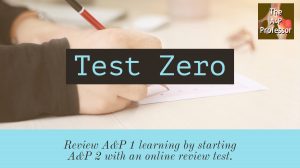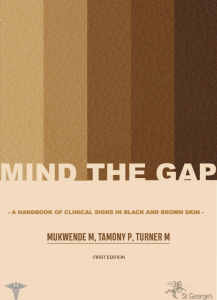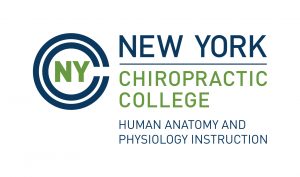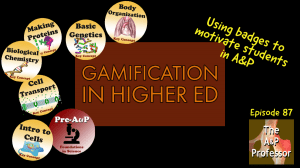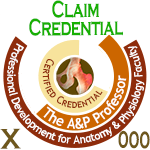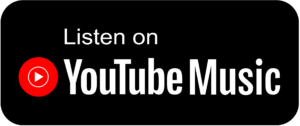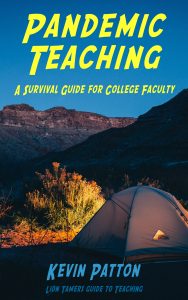Micro-Credentials & Gamification in the A&P Course | Brown & Black Skin | Refresher Tests
TAPP Radio Episode 87
Episode
Episode | Quick Take
Allowing students to earn badges in the A&P course provides motivation to master all the concepts and also provides granular documentation of learning beyond the transcripted course grade. Host Kevin Patton shares his experience, along with a discussion of skin color in teaching future health professionals and the use of refresher tests to get students ready for their A&P course.
- 00:00 | Quotation
- 00:46 | Refresher Tests
- 08:49 | Sponsored by AAA
- 10:13 | Black & Brown Skin
- 19:48 | Sponsored by HAPI
- 20:54 | Badges 1: Digital Micro-Credentials
- 29:06 | Sponsored by HAPS
- 30:07 | Badges 2: Gamification
- 38:11 | Staying Connected
Episode | Listen Now
Episode | Show Notes
“That’s what games are, in the end. Teachers. Fun is just another word for learning.” (Raph Koster)
Refresher Tests
8 minutes
A brief “refresher” on refresher tests, or as Kevin calls them… Test Zero. Pulling together ideas mentioned in past episodes, Kevin describes how he uses initial review tests in A&P 1 and a bit differently in A&P 2 to get students better prepared for their course. And he reveals the learning science behind why they work.
- Some previous episodes that mention Test Zero
Sponsored by AAA
1.5 minutes
A searchable transcript for this episode, as well as the captioned audiogram of this episode, are sponsored by the American Association for Anatomy (AAA) at anatomy.org.
Don’t forget—HAPS members get a deep discount on AAA membership!
Sign up for the new VDD or Virtual Dissection Database. You can access it at www.virtualdissectiondatabase.com
Black & Brown Skin | Book Club
9.5 minutes
A&P faculty have the awesome responsibility to “set the stage” for future health professionals. One way we can do this is to start early with an awareness of anatomic variations and how they influence observation of clinical signs. That that starts with the skin, particularly how common clinical conditions appear in a variety of skin colors. A new recommendation from The A&P Professor Book Club may help us (and our students) with that.
- Black & Brown Skin (Mind the Gap book) www.blackandbrownskin.co.uk/
- Pulse Oximeter Devices Have Higher Error Rate in Black Patients (NY Times article) my-ap.us/3q0Gkg7
- Racial Bias in Pulse Oximetry Measurement (letter in New England Journal of Medicine) my-ap.us/3jud132
- Back to Campus Pandemic Teaching | Resilience | TAPP 74 (where Kevin talks about “setting the stage” in lion taming)
Sponsored by HAPI Online Graduate Program
1 minute
The Master of Science in Human Anatomy & Physiology Instruction—the MS-HAPI—is a graduate program for A&P teachers, especially for those who already have a graduate/professional degree. A combination of science courses (enough to qualify you to teach at the college level) and courses in contemporary instructional practice, this program helps you be your best in both on-campus and remote teaching. Kevin Patton is a faculty member in this program. Check it out!
Badges 1: Digital Micro-Credentials
8 minutes
Returning to the concept of badges (which are available for podcasts, book readings, seminars, etc., in The A&P Professor universe world), Kevin talks about the value of badges both for us as professional educators and for our students. The example of the latter is Kevin’s use of badges in his Pre-A&P course.
- 86 | What a Year! | Pandemic Teaching & More | A Reflection (episode where I describe TAPP-ed badges)
- The A&P Professor Community (private online community with upcoming micro-course in micro-credentials) theAPprofessor.org/community (February 2021 subscription discount at theAPprofessor.org/Insider21
- Badgr (digital micro-credentialing platform; free for basic badging functions) badgr.com
- Education | Professional Development (TAPP-ed page that describes & links to all the badges available in The A&P Professor Education program)
- Pre-A&P Badges | And Why Should I Care? (Kevin’s student-facing web page for the badges he awards in his Pre-A&P course; list of badges & criteria; explanation of badges to students, including how to use them) lionden.com/fis-badges.htm
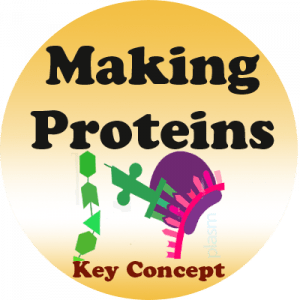
Sponsored by HAPS
1 minute
The Human Anatomy & Physiology Society (HAPS) is a sponsor of this podcast. You can help appreciate their support by clicking the link below and checking out the many resources and benefits found there. Watch for virtual town hall meetings and upcoming regional meetings!
Badges 2: Gamification
8 minutes
The digital micro-credential conversation continues with a discussion of the gamification advantage to using badges in a higher-ed course. And we circle back to the “credential” aspect of badges, too.
- Duolingo (free app for learning a new language, where Kevin is currently experiencing the advantages of gamification as he learns the Esperanto lingvo, er, language) www.duolingo.com/info
- Gamifying Education: Motivation and the Implementation of Digital Badges for Use in Higher Education (journal article) my-ap.us/3rxneig
- The Usefulness of Digital Badges in Higher Education – Exploring the Student Perspectives (journal article) my-ap.us/2MLz4GL
- The Elements of Gamification Learning in Higher Education: A Systematic Literature Review my-ap.us/36SntfJ
Discount subscription to The A&P Professor Community → theAPprofessor.org/Insider21 (good through Feb 2021)
Need help accessing resources locked behind a paywall?
Check out this advice from Episode 32 to get what you need!
Episode | Captioned Audiogram
Episode | Transcript
The A&P Professor podcast (TAPP radio) episodes are made for listening, not reading. This transcript is provided for your convenience, but hey, it’s just not possible to capture the emphasis and dramatic delivery of the audio version. Or the cool theme music. Or laughs and snorts. And because it’s generated by a combo of machine and human transcription, it may not be exactly right. So I strongly recommend listening by clicking the audio player provided.
 This searchable transcript is supported by the
This searchable transcript is supported by the
American Association for Anatomy.
I'm a member—maybe you should be one, too!
Quotation
Kevin Patton:
World class game designer Raph Koster once wrote: “That’s what games are in the end: teachers. Fun is just another word for learning.”
Aileen:
Welcome to The A&P Professor, a few minutes to focus on teaching Human Anatomy & Physiology with a veteran educator and teaching mentor, your host, Kevin Patton.
Kevin Patton:
In this episode, I discuss refresher tests, teaching about black and brown skin, and I take a brief look at microcredentials in The A&P Course.
Refresher Tests
Kevin Patton:
I want to take a moment to revisit the concept of giving our A&P students a refresher quiz; that is, a quiz we give at the beginning of a course to help students refresh their memories of concepts that they should have mastered, that we hope they mastered to some degree of competence before they came to our course. In A&P 1, that might be the basics that they pick up in their high school biology course or in whatever prerequisite course we may have. Not all the basics, but those that we know that they’ll need to succeed in mastering anatomy and physiology concepts. In A&P 2, we may want to refresh student memories of concepts learned in A&P 1 that we know they’ll need to use to understand the concepts that they’ll encounter in A&P 2.
Kevin Patton:
This whole notion of a refresher quiz or a refresher test is based on well-documented principles of learning science, namely retrieval practice, spacing and interleaving. Retrieval practice, which may be the most potent tool we have in our teaching and learning toolbox, occurs when students get practice and pulling out and dusting off and applying things that they’ve learned in the past. It could be remembering a basic fact, like where the obturator foramen is, or it could be the set of different concepts and problem-solving strategies they’ve learned before, and are now needed to answer questions about factors influencing … oh, I don’t know, signal transduction, maybe within synaptic transmission.
Kevin Patton:
Spacing is the concept that learning works best if we walk away from the concepts were learning and then come back to it. That is, we leave a little space in our learning. Having forgotten some or even all of we just learned, it turns out that we can often recover those memories or retrieve them, and in doing so, it will be even easier to recall them after more spacing before our next retrieval practice.
Kevin Patton:
Interleaving occurs when we overlap the learning and retrieval practice of different concepts, kind of mixing things up a bit. That is, mixing the concepts up and overlapping them a little bit rather than carefully leaving each concept strictly in its own little learning unit or module or chapter.
Kevin Patton:
Now, a refresher tests gets all of those strategies squarely by nudging students to start their new course by doing retrieval practice, which is what a test is, and it’s a test or retrieval practice that’s been spaced over the semester break or longer, and it covers and interleaves set of concepts that, in turn, are being interleaved with additional concepts as the new course begins. Now, that kind of spacing interleaving is not really the kind that we should be using within the main part of the course. Where spacing and interleaving work much better because the gap of learning hasn’t been so long, maybe only a couple of days. But it does have some value. How do I know that? Because I’ve done it for over a decade and it seems to really work well. I don’t have nearly as much of that disappointment at students not having what I thought they should have from their previous courses.
Kevin Patton:
But it’s not about me and my disappointment. The true value of this refreshing is that students are now better prepared and more confident as they understand the explanations of new concepts and learn how to apply them. That is, they’re in a much better place cognitively and emotionally as they tackle their new challenges in my course. Of course, each of us has our own way of doing refresher tests or quizzes.
Kevin Patton:
I’ll share mine briefly just to give you some ideas that may help you tweak your approach or to develop an approach to the refresher activity if you don’t have one. Some of this you may recognize because it’s come up in previous episodes, stretching way back to the very first months of this podcast. I’ve touched on some of these in podcasts episodes 7 and 24 and 25 and 57 and 61 and others. Now, of course, I remember those numbers right off the top of my head. No, I had to go look them up because we have a searchable transcript for each episode, which makes it easy to find what I talked about on. So 7, 24, 25, 57, just use the use search function in the website, theAPprofessor.org to find those.
Kevin Patton:
But I think it’s a good idea in this podcast, as in our courses, to bring up those past concepts, those past discussions more than once. I think we learn them more deeply that way. It’s a refresher activity, right? I call my refresher test, Test Zero, because it comes before Test One, so, yeah, okay, Test Zero then Test One and Test Two, and so on. In my A&P courses, it’s an online test that opens up the first day of class. My online tests usually run for a week or so and this one runs for about that long, sometimes a little bit longer.
Kevin Patton:
In A&P 1, it’s mostly a review of what students should have learned before coming to A&P. For example, basic cell biology, what an ion is, chemical bonds, and other basic concepts they’ve had learned in high school biology. Nobody, and I mean nobody, ever remembers all that. So some retrieval practice helps pull it back out of memory where we can start to use it in real life.
Kevin Patton:
In A&P 2, Test Zero reviews the main ideas from A&P 1. I mostly use questions from the test bank that I use to make the final exam in A&P 1. So they’re basically taking their A&P 1 exam all over again. But this time it’s online and open book and untimed. So, again, more retrieval practice. Now, they’re more likely to remember what they need to remember from A&P 1.
Kevin Patton:
For those who didn’t have my A&P 1 course, it may fill in some gaps if there are things that I’ll be touching on that other A&P faculty don’t always cover in their A&P 1 course. In both Test Zeroes, I also have a few questions from the syllabus regarding important policies, and what exactly I mean by academic integrity, and where to go when there’s a fire or tornado and so on, and, oh yeah, what my name is and how to connect with me outside of class. Hey, why not call the podcast hotline and let us all know what you do for a refresher activity or what pitfalls you’ve encountered, or, I don’t know, a question you may have about refresher activities.
Sponsored by AAA
Kevin Patton:
A searchable transcript and a captioned audiogram of this episode are funded by AAA, the American Association for Anatomy at Anatomy.org. As I mentioned in the previous episode, that is Episode 86, AAA supports many resources that are helpful to A&P faculty, including this podcast. You may recall that virtual microscopy database or a VMD that I’ve mentioned a few times in past episode. Well, guess what There’s a new virtual database that is also supported by the American Association for Anatomy. This one is the VDD, or virtual dissection database. You can access it at www.virtualdissectiondatabase.com. So once again, www.virtualdissectiondatabase.com. Just fill out the form once you’re there, you got to wait a day or two for approval, and then you can start exploring. For access to other AAA resources, just go to Anatomy.org and click Resources in the navigation ribbon.
Black & Brown Skin
Kevin Patton:
For most of us, the integumentary system is the first body system that we explore in A&P 1. There are many reasons that’s a good choice. Not the only good choice, but a good choice nonetheless. One reason is that it’s in some ways an easier system for students to understand than some other systems like, I don’t know, the nervous system, for example. Another reason is there is some useful core concepts of both structure and function that can be revealed in this system in a very understandable and practical way. Yet another reason is that the skin is a system, an organ, that is immediately observable to us. If we have healthy vision, we can see our skin and the skin of others as we learn about it. Even without any vision, we can probably feel our skin and the skin of others.
Kevin Patton:
We’ve all heard a lot of the concepts and the terminology of the integumentary system before coming into an A&P course, right? Things like keratin and collagen, and UV damage to the skin, and skin and hair color, and texture and growth, and loss, and the need for water protective skin and hair conditioning, sebum and sebaceous glands, sweat glands, nails. Well, the list just goes on and on. The point is our students come in with not just a general familiarity with skin, they’re intimately aware of a lot of the anatomy and physiology concepts of the skin, and even a lot of the scientific lingo.
Kevin Patton:
There’s one aspect of the skin that I think that we can do much better with in our A&P classes though. That is, regarding skin color. I think we’ve probably all talked about the many factors that affects skin colors such as genetics and exposure to ultraviolet radiation and hormones and various physiological processes, and even, I don’t know, make up and tattoos. We talked about melanins, the reddish, orangish pheomelanins and brown eumelanins, and we talked about other pigments. We talked about the huge variation in skin color that occurs in humans, not just from person to person, but the variations in skin color from one part of our body to another.
Kevin Patton:
I’m not sure we all carry this awareness through as fully as we could though. I know for sure that I can be better at it. For example, I need to be better at considering the variations of skin color, particularly the brown and black skin tones that we, as a society, have both ignored and exaggerated as they play out in different physiological states including disease. For example, when I talk about blushing or flushing of skin, do I give examples in very lightly pigmented skin where these processes are easiest to see and completely ignore how that plays out in darker skin? When I talk about cyanosis including the role of … yes, you guessed it … carbaminohemoglobin. Gosh, I love that word, carbaminohemoglobin. When I talk about cyanosis, do I include how that looks in very dark skin? When I talk about tanning and burning, do I use only examples from very light skin or do I bring in examples of darker skin colors? When I talk about jaundice, do I discuss how easy or difficult that may be to discern in someone with black or brown skin?
Kevin Patton:
Something that’s a significant health issue right now relates to the COVID-19 pandemic. As you know, monitoring oxygen saturation in blood is important in managing the moderate and severe cases of this disease, and that’s often using an easy to use little clip device called a pulse oximeter that goes on the tip of the finger. But the thing is that device works by measuring the color of blood moving through the skin of the fingertip. If one has dark pigment in that skin, the accuracy of the oxygen saturation of blood can be affected. I have a link to a recent article about that in the show notes and episode page.
Kevin Patton:
Now, this inaccuracy, at least occasional inaccuracy of pulse oximeters, in patients with dark skin on their fingers can be a big deal in some cases. If I have a patient or a relative or household member with dark skin, am I taking that into account as I help them monitor their blood oxygen? Are there health providers taking that into account? The thing is most of my students are future health professionals who are at the very beginning of their training. That means that I have the awesome responsibility of setting up the stage. Something I learned from my lion tame days, something I brought up in previous episodes, is that setting the stage is vital to the success of the lion act and maybe even vital to the survival of the lion tamer and the lions.
Kevin Patton:
So when it comes to future health professionals, I’m thinking I ought to be taking the opportunity I have to get my students thinking about the variations of skin color that their patients will have, because that could mean life or death or at least some kind of health danger if that stage hasn’t been set properly. What I mean by this is that if I can get my students into a mindset to automatically consider variations in skin color when it comes to cyanosis and jaundice and burns and rashes, and so on, then they’re far less likely to assume that those conditions are going to be as easy to spot in everyone or look the same in everyone as they do in light skinned examples that they see early in their training. It takes much more than a glance to spot some of those conditions in dark skin, and I’d rather get them thinking about that sort of thing now rather than having to get that later, which, sadly, they may not get.
Kevin Patton:
So popping into my local bookstore, I think I’ll pick up a copy of the newest recommendation in The A&P Professor Book Club. It’s called Mind the Gap: A Handbook of Clinical Signs in Black and Brown Skin. Okay, I’m not going to really find it in my local bookstore, I just wanted to play that little doorbell sound, because I like the sound of it. it has a ring to it, right? Like the word carbaminohemoglobin. That kind of has a ring to it, too, doesn’t it?
Kevin Patton:
Well, anyway, this book, Mind the Gap, is only available online as a free downloadable file. It’s not in the bookstore. So where you go to get it is www.blackandbrownskin.co.uk, and that link is also listed in the show notes and the episode page. Now this manual was created last year by Malone Mukwende, Peter Tamony, and Margot Turner as a supplement to the gap that exists in medical and health professions training resources. It’s an admitted first try and it seems like this project will likely grow over time. They’re already adding new conditions and new photographs, so if you’ve been in there to look at it before, you may want to check it again and look at the new content that they’ve added, maybe even go back in there regularly. Maybe review it each time you’re ready to start teaching the skin.
Kevin Patton:
Now, I think this project is also going to spark mainstream reference in training materials to help address that gap, too, so I think it’s going to be a catalyst; and all of that together can help improve health outcomes and save lives. A great thing for us as A&P teachers is that this resource gives a place to start with our students, a resource to use for teaching and learning, and for setting the stage properly for our future health professionals.
Sponsored by HAPI
Kevin Patton:
Hey, ever thought of taking a course or two from me and a group of other well-seasoned veteran A&P faculty, plus a few experts in contemporary teaching practice, including online and remote strategies? Well, maybe you should look into the Master of Science in Human Anatomy & Physiology Instruction, the HAPI degree. It’s the HAPI degree that pays the distribution cost so that you can listen to this podcast for free, and it’s the HAPI degree that has provided amazing professional training to hundreds of your colleagues in A&P education. Whether it’s you or someone you know who wants to up their game in A&P teaching while brushing up on content in every essential area of both anatomy and physiology, well, now is a good time to go to nycc.edu/hapi … that’s H-A-P-I … or click the link in the show notes or episode page.
Badges 1: Digital Micro-Credentials
Kevin Patton:
In the previous episode, Episode 87, I mentioned that microcredentials in the form of digital badges and certificates are available to document your professional development as you engage with this podcast and other resources available in The A&P Professor universe. Wow, that sounds pretentious, universe. Okay, let’s say available in the world of The A&P professor. Yes, world, that’s way less pretentious than universe. Hell, but you know what I mean. It’s not just the podcast, there’s the website and then community and the book club and all that stuff.
Kevin Patton:
Anyway, I said then that I’d get back to this idea of microcredentials, and, well, that time is now. First of all, I want to define microcredentials. We can say that that’s the documentation or certification of small units of experience or learning. Digital microcredentials usually reside in a person’s digital backpack, where they can be organized into groups and shared either individually or in those groups. Where do we share them? Well, you can put them on LinkedIn or other digital profiles. You can put them in your résumé or CV, personal or professional webpage, maybe digital promotion or tenure pocket, a job application, all kinds of digital platforms and digital documents.
Kevin Patton:
Besides showing off your badges at your next scouting camp out, what good are they for us as professional educators? Well, they document the little stuff. They’re microcredentials after all. All those things we do like workshops and one-day courses, and self-learning like reading a book and conferences and seminars where we really do learn something useful, something we can either use now or use later in our profession. All those skills that we pick up along the way that we often forget to document, but are often as important as the skills we learned in our degree programs. Just think of all the course design skills we’ve been pushed in to learning during our year of pandemic teaching, and specific technical skills like video web meetings, online lab sessions, perhaps some advanced skills and video, using a webcam, using a document camera, creating multimedia and all kinds of fancy LMS skills, and roping and writing and juggling and tightrope walking, and even lion taming. All that stuff we’ve learned in a hurry during the pandemic.
Kevin Patton:
So that’s why I’ve introduced the TAPP-ed program. Remember, TAPP-ed is short for The A&P Professor Education. So you can earn badges or certificates, your choice, to document all the things you’re learning here. But I’m going to focus more on how we can use microcredentials in our A&P courses. I’ve been doing this for many years in my pre-A&P course, and I think it works really well in a couple of different ways. First of all, my pre-A&P course is a refresher course, organized into 10 different modules. Each module is a set of concepts that students should have mastered before coming in to A&P 1. These are science basics, introductory chemistry, biological chemistry, introduction to cells, cell transport, getting energy, making proteins, introductory genetics, tissues, and the human body.
Kevin Patton:
Now, in pre-A&P, my students get a microcredential, that is, a badge, for each of these 10 concept groups. In the A&P course, like A&P 1 or A&P 2, or if you have a combined one semester A&P, or if you have just A or just B, one could award a badge for, I don’t know, each system of a body or each region of a body, or for particular concepts like homeostasis or histology, or for lab skills like microscopy or brain dissection or bone identification, or anything that you think is worthwhile and therefore worth documenting.
Kevin Patton:
Now, the caveat is that it ought to be tied to something you already measure or assess and document in your course, like maybe with a quiz or a test or a lab practical or a project or some combination of these measurements. Something else to consider is we might want to award badges for participation. So it wouldn’t necessarily be part of our grade or anything, but they would get some documentation and some kind of digital reward for a certain level of participation or attendance.
Kevin Patton:
The other thing to consider is what level of competence in that skill or concept mastery is needed to earn the badge? I have some students do not so good on one of their lab practicals, but still managed to pass the lab course. I don’t think they deserve a badge for those skills or concepts where they performed under par. Even if they passed a practical, my view is that they deserve a badge only when they do particularly well, and this is tied to whether the badge really means something or not. If I give a skeleton badge to every student who passes the skeleton practical, that badge won’t be as meaningful as when I award the skeleton badge only to students who reached an A or B level, or splitting the difference, B+ level, or whatever I think demonstrates actual mastery.
Kevin Patton:
I use Canvas as my learning management system or LMS in that course, but any LMS can work for awarding badges. What I’ve done is create a free badge issuer account at badgr.com … that’s B-A-D-G-R … badgr.com, and I create a badge for each module. Then I link my Badgr issuer account to my Canvas course. All of these are easy steps and I’m going to offer a micro-course this spring at theAPprofessor.org/community to walk you through it all step by step. But you can go to Badgr and they have some resources there that walk you through most of these.
Kevin Patton:
Now, once I have this all set up in my course, when a student earns at least 85% in a module, that is a B or better, they automatically earn a badge. I don’t have to do anything other than set that up at the beginning of the course. When a student has earned all the badges in a course and passed the final exam with a B or better, they can earn a badge for successfully mastering the whole course. I’ll be back with more in just a few seconds.
Sponsored by HAPS
Kevin Patton:
Marketing support for this podcast is provided by HAPS, the Human Anatomy & Physiology Society, promoting excellence in the teaching of Human Anatomy & Physiology for over 30 years. I’ve been getting a lot out of that town hall meeting sponsored by HAPS recently. The most recent one about using inclusive language in our teaching was both challenging and supportive, as most of the HAPS events are. Something else I’ve enjoyed is the new HAPS Book Club, which is just about to start a new round of discussions, this time, about the book called Fatal Invention, which was written by Dorothy Roberts. For more info about the book club, the town halls, and, well, lots of other resources, just go visit HAPS at theAPprofessor.org/haps. That’s H-A-P-S.
Badges 2: Gamification
Kevin Patton:
I’ve been describing how I use badges in my pre-A&P course; specifically, how these badges act as digital microcredentials that document specific concepts or skills that my students have mastered. But something else that my students get out of this course that has badges is the advantage of gamification. What that means is that by awarding badges, I’ve introduced an element of gaming or gameplay into the learning process. As the world class game designer Raph Koster has said, “That’s what games are in the end: teachers. Fun is just another word for learning.” I know from my experience with lions and other wild animals, they learn how to hunt by playing hunting games. That’s how we trained our lions. We let them play and simply reinforce what they already have fun doing and got them to do it on cue using food rewards.
Kevin Patton:
Now, I’m not a digital gamer, really, but I’ve done enough stuff online like playing Solitaire on my iPhone as a kind of meditation to have experience the earning of badges or coins or gems or whatever for reaching certain goals or levels of skill. As a matter of fact, right now, I’m using the Duolingo app to learn the Esperanto language. Duolingo uses a lot of proven learning science to teach people a new language, and that includes gamification. For example, I earned XPs or experience points the more retrieval practice I do in Duolingo. Competing against other users, I might earn enough XPs to move me from the Pearl League to the Obsidian League. Whoo! That’s okay, I kind of like Obsidian, so I’m looking forward to that.
Kevin Patton:
I want to do that, but I don’t care what it was, whether it’s Obsidian or Sapphire or Emerald or … I don’t care. I just want to move up. That’s motivating to me. You know what? Even though my only goal really is to learn the Esperanto language, I do watch my XPs. I keep an eye on them and how far away I am from moving up to a higher league, and I want to advance in skill levels and earn all those little things that have no intrinsic value and sound downright silly when I say them out loud. But it turns out that they really do add to my motivation in keeping going.
Kevin Patton:
Now, honestly, learning Esperanto is great fun for me, and I would continue with it without the gamification offered by the Duolingo app. But, it turns out, that gamification has amplified the fun and thereby amplified the motivation to keep going. Now, when I first ran across the idea of gamification in teaching 10 years ago or so, I thought that was something for elementary school learning, not for the advanced learning of A&P. But there’s all kinds of evidence that it works. Even if something sounds childish or silly or odd, it can still work, and sometimes it can work powerfully.
Kevin Patton:
So, yeah, I think my initial reaction to gamification was typical, like, “Um, right. I’m going to make my course into a game. Um, no. If my students are motivated enough by getting a good grade, then giving them make-believe badges is just a silly waste of time. What would my department peers be saying about me? if I did that? Nope, ain’t going to happen in my course.” Then I start running across more and more and more evidence, I mean documented scholarly evidence and testimonials, and after a while I just went ahead and tried it anyway. You know what, it works, at least for some students and that’s good enough for me.
Kevin Patton:
Gamification is by itself a good reason to add badges to your course, but there is that other aspect of badges, which is the microcredentialing part of it. If one of my students came to you with a passing grade in my pre-A&P course, would you know what that signifies? Would you know what concepts they’ve mastered? Even after listening to this episode, that might be pretty fuzzy. But when you see that they’ve earned a badge in protein synthesis, now you know something more, something deeper, something more granular about their learning mastery and you can easily click on that badge to go to the criteria to see even more granular information about what specific learning outcomes they have achieved. They can take that digital badge anywhere, displaying it in any digital medium, and it’ll link right back to where all those details are. Even the fact that they needed to get an 85% or better in order to earn it.
Kevin Patton:
Something else about microcredentials is that they’ve been a little slow in being adopted in higher education. No wonder they sound childish, so they’ve been a huge hit at elementary school levels, but they’re only slowly developing a following at the higher ed levels. But there’s pretty strong evidence that’s about to shift pretty suddenly and pretty soon and I’d rather my students be ahead of that curve. I think they’ll have an advantage in already having some meaningful microcredentials in their digital backpacks when microcredentials become more widely used in higher education. Microcredentials are already in more widespread use in many professions and industries, particularly in professions that require and value continuing professional education and that includes the health professions. So my students will have that advantage of being ahead of others in their cohort as they move into their professional careers.
Kevin Patton:
Microcredentials, like badges and certificates, may be something you want to add to your A&P course to both motivate your students while they’re in the course, and give them some specific credentials that they can take with them as they continue on their professional path. Maybe you don’t want to do it now, I get that. Hard times right now, overwhelming times in teaching these days, right? But I’m just planting a seed for now.
Staying Connected
Kevin Patton:
If you found this episode helpful or interesting, there’s an easy way to share this podcast with a peer, and also earn yourself a bit of cash. Simply go to theAPprofessor.org/refer, to get a personalized share link that will not only get your friend all set up in a podcast player of their choice, it’ll also get you on your way to earning a cash reward. Refer two friends and you get $5. Refer 10 friends and you get $25. What a deal. Oh, by the way, if you don’t see links in your podcast player, go to the show notes at the episode page at theAPprofessor.org/87, where you can explore any ideas mentioned in this podcast. And you’re always encouraged to call in with your questions, comments and ideas at the podcast hotline. That’s 1-833-LION-DEN, or 1-833-546-6336, or send a recording or written message to podcast@theAPprofessor.org.
Kevin Patton:
You’ve invited to join my private A&P teaching community way off the social platforms where we’ll soon be going over that badge thing in a lot more detail within a micro course that can earn you a badge, too. Now, to claim the insider’s plan, just go to theAPprofessor.org/insider21 before the end of February. I’ll see you down the road.
Aileen:
The A&P Professor is hosted by Dr. Kevin Patton, an award-winning professor and textbook author in Human Anatomy & Physiology.
Kevin Patton:
Translations of any content into languages other than English are intended solely as a convenience to the non-English speaking public and are not legally binding.
This podcast is sponsored by the
Human Anatomy & Physiology Society 
This podcast is sponsored by the
Master of Science in
Human Anatomy & Physiology Instruction 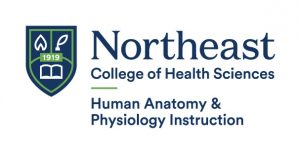
Transcripts & captions supported by
The American Association for Anatomy. 
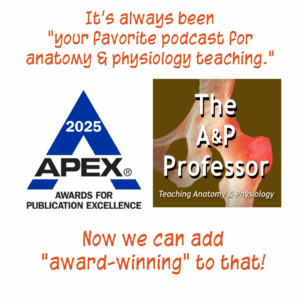
Stay Connected
The easiest way to keep up with new episodes is, um, wherever you already listen to audio!
Click here to be notified by email when new episodes become available (make sure The A&P Professor option is checked).
Call in
Record your question or share an idea and I may use it in a future podcast!
Toll-free: 1·833·LION·DEN (1·833·546·6336)
Email: podcast@theAPprofessor.org
Share

Kevin's bestselling book!
Available in paperback
Download a digital copy
Please share with your colleagues!
Tools & Resources
TAPP Science & Education Updates (free)
TextExpander (paste snippets)
Krisp Free Noise-Cancelling App
Snagit & Camtasia (media tools)
Rev.com ($10 off transcriptions, captions)
The A&P Professor Logo Items
(Compensation may be received)
🏅 NOTE: TAPP ed badges and certificates can be claimed until the end of 2025. After that, they remain valid, but no additional credentials can be claimed. This results from the free tier of Canvas Credentials shutting down (and lowest paid tier is far, far away from a cost-effective rate for our level of usage). For more information, visit TAPP ed at theAPprofessor.org/education

